
The Fauve de Bourgogne is a stocky medium-sized breed of rabbit which is orange-red in color. [1]

The Fauve de Bourgogne is a stocky medium-sized breed of rabbit which is orange-red in color. [1]
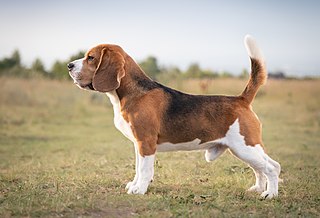
The beagle is a breed of small scent hound, similar in appearance to the much larger foxhound. The beagle was developed primarily for hunting rabbit or hare, known as beagling. Possessing a great sense of smell and superior tracking instincts, the beagle is the primary breed used as a detection dog for prohibited agricultural imports and foodstuffs in quarantine around the world. The beagle is a popular pet due to its size and good temper.

The Ibizan Hound is a lean, agile dog of the hound family. There are two hair types of the breed: smooth and wire. The more commonly seen type is the smooth. Some consider there to be a third type, long, but the longhair is most likely a variation of the wire.

The Pharaoh Hound or Kelb tal-Fenek is a Maltese breed of hunting dog. It is traditionally used for rabbit-hunting in the rocky terrain of the islands; the Maltese name means "rabbit dog".
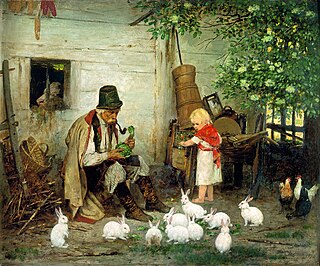
Cuniculture is the agricultural practice of breeding and raising domestic rabbits as livestock for their meat, fur, or wool. Cuniculture is also employed by rabbit fanciers and hobbyists in the development and betterment of rabbit breeds and the exhibition of those efforts. Scientists practice cuniculture in the use and management of rabbits as model organisms in research. Cuniculture has been practiced all over the world since at least the 5th century.

The Angora rabbit, one of the most ancient groups of domestic rabbit breeds, which is bred for the long fibers of its coat, known as Angora wool. They are gathered by shearing, combing or plucking. Because rabbits do not possess the same allergy-causing qualities as many other animals, their wool is an important alternative. There are at least 11 distinct breeds of Angora rabbit, four of which are currently recognized by the American Rabbit Breeders Association (ARBA): the English Angora, the French Angora, the Giant Angora and the Satin Angora. Other unrecognized breeds include the German Angora, the Finnish Angora, the Chinese Angora, the Japanese Angora, the Korean Angora, the Russian Angora, the St Lucian Angora and the Swiss Angora.

The Netherland Dwarf is a breed of domestic rabbit that originated in the Netherlands. Weighing 1.1–2.5 pounds (0.50–1.13 kg), the Netherland Dwarf is one of the smallest rabbit breeds. Its popularity as a pet or show rabbit may stem from its neotenic appearance. The Netherland Dwarf is recognised by both the American Rabbit Breeders Association (ARBA) and the British Rabbit Council (BRC). The Netherland Dwarf is often confused with the Polish breed of rabbit, but the latter has longer ears, a non-brachycephalic head and less cobbiness.

The domestic rabbit is the domesticated form of the European rabbit, a member of the lagomorph order. A male rabbit is known as a buck, a female as a doe, and a young rabbit as a kit. There are hundreds of rabbit breeds, originating from all over the world.

Dwarf rabbit refers either (formally) to a rabbit with the dwarfing gene, or (informally) to any small breed of domestic rabbit or specimen thereof, or (colloquially) to any small rabbit. Dwarfism is a genetic condition that may occur in humans and in many animals, including rabbits. True dwarfism is often associated with a cluster of physical abnormalities, including pituitary dwarfism. The process of dwarfing is used to selectively breed for smaller stature with each generation. Small stature is a characteristic of neoteny, which may account for the attraction of dwarf animals.
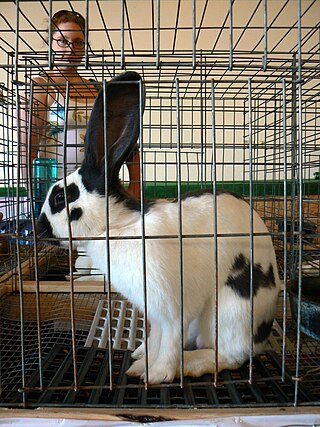
The American Rabbit Breeders Association (ARBA) is a national club for domestic rabbits and cavy breeders. The ARBA is headquartered in Knox, Pennsylvania in the United States. Its membership is composed of rabbit and cavy exhibitors, commercial breeders and pet owners in North America and many countries throughout the world.

The Californian, also known as the California White, is a breed of domestic rabbit initially developed for the fur and meat industries by George S. West of Lynwood, California, starting in 1923. West maintained a herd of 300 genetically pure New Zealand Whites, which he began crossing with Standard Chinchilla rabbits for their dense coat and Himalayan rabbits. This new breed, named after the state of its origin, was first shown in 1928, and a standard was accepted by the American Rabbit Breeders Association (ARBA) in 1939.

The Mini Lop is a breed of domestic rabbit that is recognized by the American Rabbit Breeders Association (ARBA). It is different from the Miniature Lop breed that is recognized by the British Rabbit Council (BRC). The Mini Lop [US] and the Miniature Lop [UK] are different from the Dwarf Lop breed that is recognized by the BRC. The Mini Lop is similar to several other small rabbit breeds, such as the Dwarf rabbit.

The Holland Lop is a breed of lop-eared rabbit that was recognized by the American Rabbit Breeders Association (ARBA) in 1979. The Holland Lop, with a maximum weight of 1.8 kg (4 lb), is one of the smallest lop-eared breeds.
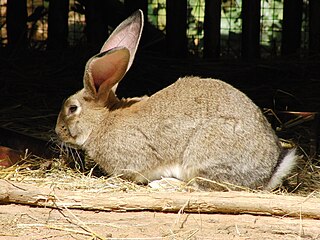
The Flemish Giant rabbit is the largest breed of domestic rabbit. They weigh 6.8 kilograms on average, though the largest ones can weigh up to 22 kilograms. Historically they are a utility breed used for their fur and meat. In the modern day, they are no longer commonly raised for meat, due to their slow growth and very large bones, and are raised for exhibition at rabbit shows. They are often kept as pets as they are known for being docile and patient when being handled.
Lop rabbit or lop-eared rabbit refers to any rabbit with ears that droop, as opposed to being carried erect. A number of rabbit breeds are characterized by such lop ears. Abnormalities in the skull of a half-lop rabbit were studied by Charles Darwin in 1868.

The term rex rabbit refers informally to one of at least eight breeds of domestic rabbit. One such breed is the Rex, which is recognized by the American Rabbit Breeders Association (ARBA) and by the British Rabbit Council (BRC). Other modern-day rex rabbit breeds are listed below. Care must be taken to distinguish the rex rabbit breeds from the three types of rex rabbit fur for which they are known.
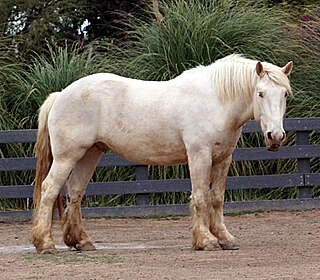
In modern agriculture, a rare breed is a breed of poultry or livestock that has a very small breeding population, usually from a few hundred to a few thousand. Because of their small numbers, rare breeds may have a threatened conservation status, and they may be protected under regional laws. Many countries have organizations devoted to the protection and promotion of rare breeds, for which they each have their own definition. In botany and horticulture, the parallel to rare animal breeds are heirloom plants, which are rare cultivars.

The New Zealand is a breed of rabbit, which despite the name, is American in origin. The breed originated in California, possibly from rabbits imported from New Zealand. New Zealand rabbits are available in five colors recognized by the American Rabbit Breeders' Association (ARBA): white, red, black, blue, and broken. Crossbreeding can result in many other variations, such as gold tipped steel and chestnut agouti. They average 10–12 lb (4.5–5.4 kg) with the does being slightly larger than the bucks. New Zealands are bred for meat, pelts, show, and laboratory uses, being the most commonly used breed of rabbit both for testing and meat production. They are also bred as pet rabbits but mostly breed for meat.
The Perdigueiro Galego is a rare breed of pointer from the autonomous community of Galicia in north-western Spain. It is one of four traditional breeds of the region, the others being the Can de Palleiro, the Guicho or Quisquelo, and the Podengo Galego.